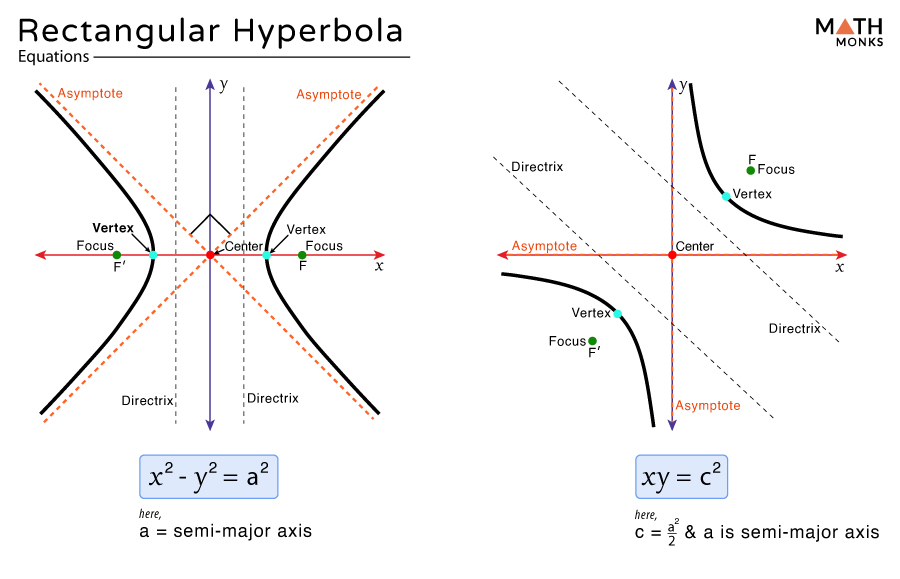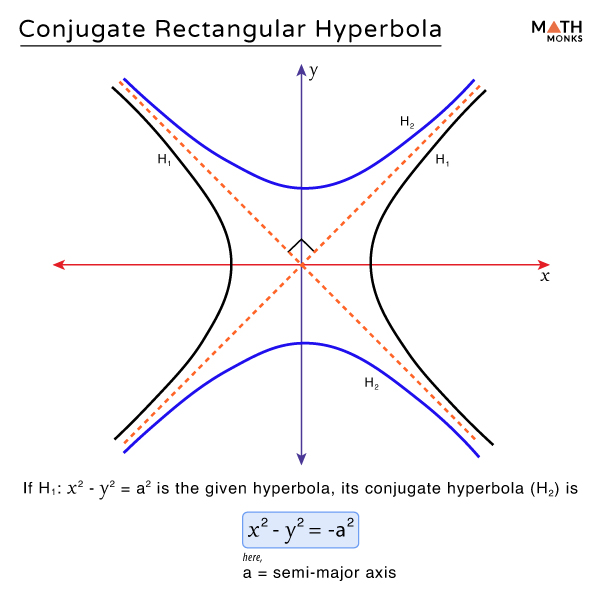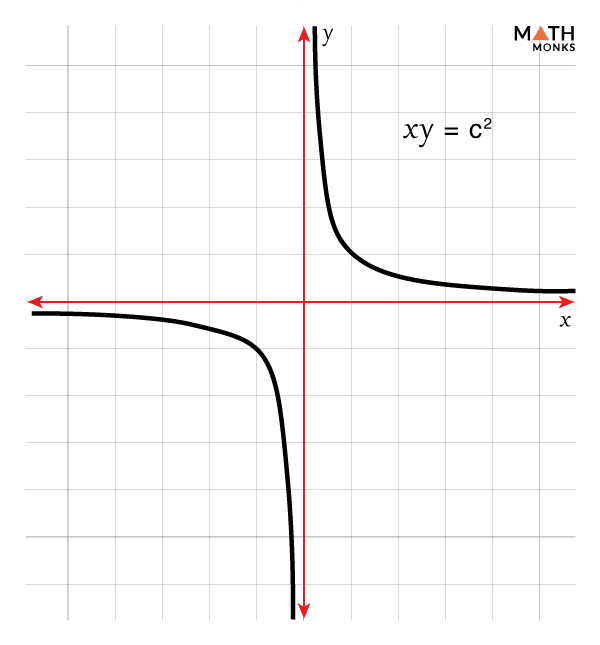A rectangular hyperbola, also known as an equilateral hyperbola, is a special type of hyperbola in which the transverse and conjugate axes are of equal length. It shares all the properties of a general hyperbola, with the main difference being its asymptotes are perpendicular to each other (orthogonal), forming a right angle.
Given that the transverse axis has a length of 2a and the conjugate axis has a length of 2b, we have 2a = 2b, which simplifies to a = b.
Equations
Based on its center and asymptotes, the equation of a hyperbola has two forms: standard and parametric.
Standard Form – Centered at (0, 0)
The general equation of a Rectangular Hyperbola centered at (0, 0) is:
x2 – y2 = a2
If the center is at (0, 0) but the asymptotes are aligned with the horizontal and vertical axes (x and y axes), then the general equation changes to:
xy = c2, here c2 = ${\dfrac{a^{2}}{2}}$ is a constant that determines the scale of the hyperbola.
Standard Form – Not Centered at (0, 0)
If the center is located anywhere apart from the center, say (x0, y0), then the equation of the rectangular hyperbola becomes:
(x – x0)2 – (y – y0)2 = a2
Parametric Form
The parametric equation of a rectangular hyperbola is:
x = a secθ
y = a tanθ
However, unlike general hyperbolas, rectangular hyperbolas range over all angles where the secant and tangent functions are defined. The range typically spans from 0° to 180° (i.e., 0° ≤ θ ≤ 180°) except where secθ and tanθ are undefined (i.e., where cosθ = 0 or sinθ = 0)
Conjugate
The conjugate of the rectangular hyperbola x2 – y2 = a2 is also a rectangular hyperbola. The equation of its conjugate is x2 – y2 = -a2. The transverse and conjugate axes of a hyperbola become the conjugate and transverse axes of its conjugate. Together, these axes form a pair of asymptotes.
Asymptotes
For a rectangular hyperbola, the equation of the asymptotes is:
y = ±x or x2 – y2 = 0
Thus, the asymptotes are parallel.
Eccentricity
As we know, the eccentricity of the hyperbola is ${e=\dfrac{\sqrt{a^{2}+b^{2}}}{a}}$
Since, in a rectangular hyperbola, a = b
${e=\dfrac{\sqrt{a^{2}+b^{2}}}{a}}$
⇒ ${e=\dfrac{\sqrt{a^{2}+a^{2}}}{a}}$
⇒ ${e=\sqrt{2}}$
Thus, the eccentricity of a rectangular hyperbola is ${\sqrt{2}}$
Foci
As we know, the foci of the hyperbola are (±ae, o)
Since, in a rectangular hyperbola, the eccentricity is e = ${\sqrt{2}}$
Thus, the foci of a rectangular hyperbola is ${\left( \pm a\sqrt{2},0\right)}$
Directrix
As we know, the directrices of the hyperbola is ${y=\pm \dfrac{a}{e}}$
Since the eccentricity of a rectangular hyperbola is e = ${\sqrt{2}}$
Thus, in a rectangular hyperbola, the equation of the directrices is ${y=\pm \dfrac{a}{\sqrt{2}}}$
Graphing
The graph of the Rectangular Hyperbola with the equation xy = c2 (c is a constant) is shown.
The graph of the equation ${y= \dfrac{1}{x}}$ is similar to the graph of a rectangular hyperbola.
Solved Examples
![]() If a rectangular hyperbola has a transverse axis of 10 units and its axes coincide with the coordinate axes, find its equation.
If a rectangular hyperbola has a transverse axis of 10 units and its axes coincide with the coordinate axes, find its equation.
Solution:
![]()
Given that the coordinate axes of the hyperbola are its axes.
As we know, the equation of the rectangular hyperbola is x2 – y2 = a2
Here,
The length of the transverse axis is
2a = 10
⇒ a = 5
Now, the equation of the rectangular hyperbola is
x2 – y2 = 52
⇒ x2 – y2 = 25
Thus, the equation of the rectangular hyperbola is x2 – y2 = 25
![]() If the rectangular hyperbola is given by the equation x2 – y2 = 36, find its foci, length of the transverse axis, and length of the latus rectum.
If the rectangular hyperbola is given by the equation x2 – y2 = 36, find its foci, length of the transverse axis, and length of the latus rectum.
Solution:
![]()
Given the rectangular hyperbola is x2 – y2 = 36 …..(i)
As we know, the standard equation of the rectangular hyperbola is x2 – y2 = a2 …..(ii)
On comparing the equations (i) and (ii), we get
a2 = 36
⇒ a = 6
Thus,
The foci are ${\left( \pm a\sqrt{2},0\right)}$ = ${\left( \pm 6\sqrt{2},0\right)}$
The length of transverse axes = 2a = 2(6) = 12 units
The length of the latus rectum = 2a = 2(6) = 12 units
Thus, the foci of the rectangular hyperbola are ${\left( \pm 6\sqrt{2},0\right)}$, the length of the transverse axis is 12 units, and the length of the latus rectum is 12 units.



